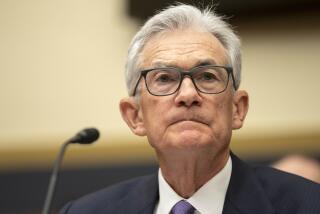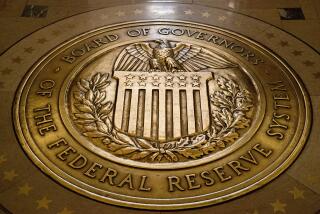Fed stays the course on rates
The Federal Reserve seemed to give investors and the business world just about everything they wanted to hear.
The Fed endorsed the view that the sharp contraction in the first quarter was a blip: The economy has rebounded from the weather-related soft patch. Business investment now is bouncing up and labor markets are improving, the central bank said in its statement after its policy meeting Wednesday.
At a news conference, Fed Chairwoman Janet L. Yellen said she didn’t think that stock valuations and investors’ reach for higher bond yields were out of line. Nor was she terribly worried about global instability, though she did note that the developments in Iraq presented a risk for energy supplies and prices.
As for recent signs of higher inflation in the U.S.? “Noisy data,” Yellen said.
“I think the recent evidence we have seen, abstracting from the noise, suggests that we are moving back gradually over time toward our 2% objective,” Yellen told reporters in referring to the Fed’s target for inflation.
Wall Street certainly liked what it heard. Stocks began rising during Yellen’s afternoon news conference and moved steadily higher up to the closing bell, with the Dow hitting a fresh record of 16,906.62.
The Fed continued to trim the size of its bond-buying stimulus. The purchases, aimed at holding down long-term interest rates, were cut another $10 billion and will stand at $35 billion a month starting in July. The program, which the Fed and other experts believe has lost much of its bang, is expected to wind down completely by year’s end.
But the Fed left its benchmark short-term interest rate, its main policy tool, near zero and gave no signal that it would start raising that rate any sooner than the mid-2015 period that market analysts had expected.
Some economists have called for an earlier shift in what’s known as the federal funds rate, which influences borrowing costs for individuals and businesses. They contend that the economy has strengthened enough and that keeping the federal funds rate at a rock-bottom level is an invitation to speculation and bubbles, not to mention higher inflation down the road.
Yellen and her colleagues, however, raised their projection for inflation this year by just a notch, to a high of 1.7%, from their March projection of 1.6%.
Christopher Thornberg, founding partner of Beacon Economics, agreed with the Fed’s assessment.
“We don’t have the conditions for a high inflation situation,” he said. “Money supply growth is very constrained. Banks aren’t lending. [Yellen] doesn’t have to worry about big-time inflation.”
The Fed’s policy meeting this week was the third headed by Yellen, who succeeded Ben S. Bernanke on Feb. 3. She has since won unanimous support from her colleagues, including three new voting committee members who signed the Fed’s statement Wednesday. But some Fed members are known as inflation hawks, so that honeymoon may be over before long.
“Hawks are squawking, which shows up in more upside risks on the inflation outlook than we saw in March,” Diane Swonk, chief economist at Mesirow Financial, said in a note to clients.
“Look for the next battle, and a last chance for hawks to make a stand, after the Fed completes its current round of asset [bond] purchases,” she said.
The Fed has a dual goal of fostering maximum employment and price stability. Yellen made clear Wednesday that while the labor market has continued to heal, it was still far from healthy.
Even though the nation’s jobless rate has fallen faster than expected, to 6.3% last month from 6.7% in March, Yellen and others frequently have pointed to the many idled workers and others marginally attached to the job market who are not captured in the official jobless figure.
“I think a portion of the decline we’ve seen in the unemployment rate probably reflects a kind of shadow unemployment or discouragement,” Yellen said Wednesday.
Also, the Fed statement again noted the slow housing recovery, something that Yellen attributed at least partly to persistently tight credit conditions even five years after the end of the Great Recession. Some economists and bankers said the broader economy won’t perform to potential until home building regains momentum.
“The country needs to get construction growing again at a stronger clip,” said Russell Goldsmith, chief executive of City National Bank in Los Angeles. “Until we do, it’s hard to see the [economic] growth rate at 3% or 31/2%.”
Goldsmith said he was generally encouraged by the Fed’s statement, noting that it “reflects the economy is slowly establishing itself as a self-sustaining recovery.”
Yet because of the hit from the first quarter, Fed officials knocked down projected U.S. economic growth for this year to 2.1% to 2.3%. That’s about average for the last five years of recovery from the Great Recession, and down sharply from the Fed’s March forecast of 2.8% to 3%.
The rest of this year looks much stronger, and the Fed said growth should pick up to about 3% next year and in 2016.
Looking further out, however, Fed officials are not so bullish. Like other economists, most Fed policymakers think that economic growth in the long run will average just a little over 2%, reflecting slower labor force growth and gains in productivity.
It may be with that in mind that most Fed officials now see the benchmark short-term interest rate — and, thus, overall consumer and business lending rates — at lower than historical levels in the long run.
As for unemployment, the latest Fed projections show the jobless rate dropping faster than it had previously forecast, to as low as 6% by year-end and 5.4% at the end of 2015. If it were to fall that low next year, it would be close to full employment.
Some other forecasters are not so optimistic. Economists at the International Monetary Fund predicted this week that the U.S. probably wouldn’t reach full employment until 2017.
Since the recovery began, the Fed has frequently had to downgrade what turned out to be its overly optimistic economic growth projections, even as policymakers in the last couple of years have underestimated the drop in the unemployment rate.
Asked whether she was confident about the latest forecast for a pickup in economic activity, Yellen responded:
“Well, when you say ‘confident,’ I suppose the answer is no because there is uncertainty. But I think there are many good reasons why we should see a period of sustained growth in excess of the economy’s potential.”
And she rattled off a few.
“We have a highly accommodative monetary policy, we have diminishing fiscal drag, we have easing credit conditions, we have households who are becoming more comfortable with their debt levels and are more able to service debt, an improving job market,” Yellen said.
“We have rising home prices and rising equity prices and an improving global economy, at least in my estimation.”
Lee reported from Washington and Hsu from Los Angeles.








